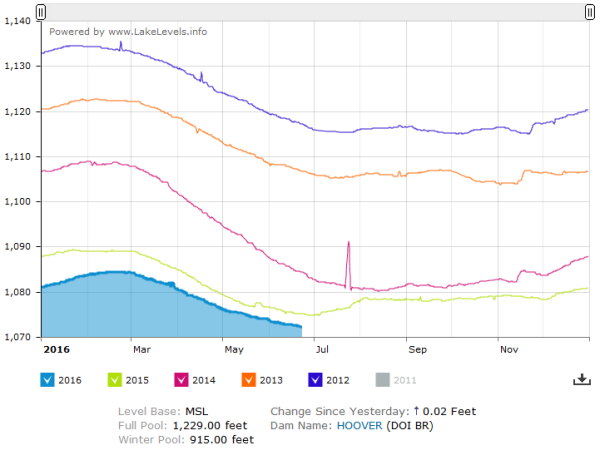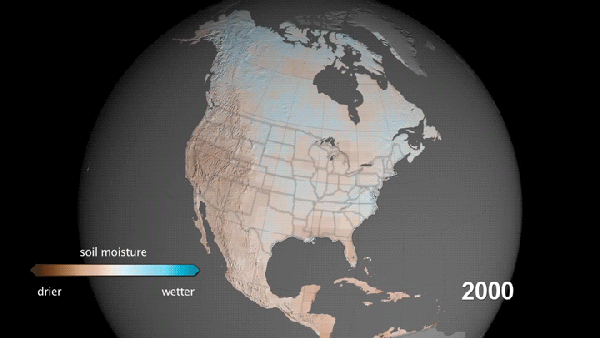Water Knives in the Near Future — 16 Year Drought Brings Lake Mead To New Record Low
23
June, 2016
It’s
been ridiculously hot along the unstoppable shrinking shoreline at
Lake Mead. Over
the past four days, highs have peaked at a scorching 109 to 111 F (42
to 44 C).
Similar heat blasted all up and down the Colorado River Basin,
squeezing moisture out of a key water supply for 25 million people in
California, Arizona, and Nevada.
(NASA
predicts that 20-30 year droughts in the US West will become 80
percent more likely due to human-forced warming. For Lake Mead, the
reality of mega-drought appears to already be settling in.)
But
these record hot days are just the most recent of many for the river
and its water. For over the past 16 years the Colorado River has been
assailed by drought. A new kind of mega-drought that has almost
certainly been spurred by a human-forced warming of the world. A
condition of endemic drying that will likely continue to worsen for
the foreseeable future.
Lake
Mead Approaching Mandatory Rationing Levels
1072.24
feet — that’s
the water level for Lake Mead as of June 21, 2016.
It’s about 3 feet below the 1075 mark breached for the first time
in the reservoir’s history last year. And if Lake Mead remains
below that line by the end of this year, it will mean mandatory cuts
to Arizona and Nevada’s water supply.
That
could happen either this year (2016) or next (2017) and will almost
certainly happen by 2018. In fact, the US Bureau of Reclamation
predicts a 64 percent likelihood that Lake Mead will not only remain
below the 1075 foot level by 2019, but that it will plunge to as low
as 1025 feet at that time.
(Lake
Mead may average near or below the 1075 line requiring mandatory cuts
in water supplies to Arizona and Nevada this year. Image source: Lake
Mead Water Level.)
This
level is only 125 feet above Lake Mead’s dead pool line of 900
feet. And hitting such a low water level would result in mandatory
water cuts all up and down the Colorado River Basin.
Lake
Mead supplies water to 25 million people in Nevada, Arizona, and
California.
19 million of these people reside in California alone. And according
to the 1922 Colorado River Compact, California retains senior rights
to the river’s water supply. What this means is that when there’s
a shortage, Nevada and Arizona have to take the first hits. And
that’s bad news for the six million people and related industries
supported by the river in this region. It means that if the 16 year
drought along the Colorado River basin continues — and that will
likely be the case due to impacts related to human-caused climate
change — then water rationing is almost certain to take effect in
Arizona and Nevada over the next few years.
(Weather
systems that bring rain to the US Southwest are becoming more rare.
Scientific studies indicate that this condition is caused by human
forced climate change and will continue to worsen this Century if
fossil fuel burning and human based carbon emissions do not halt
soon. Image source: Climate
Central.)
If
the climate change driven drought continues and Bureau of Reclamation
forecasts are correct, then hitting 1025 feet at Lake Mead by 2019 to
2022 will result in The Department of the Interior stepping in to
take control of Lake Mead’s water management. At that point, all
bets are off even for California — which
would likely then see a 10 percent reduction in the water provided to
it by Lake Mead.
Water
Knives in the Hothouse Sun
Scientific
studies indicate that factors related to human-caused climate change
prevent weather systems bearing precipitation from reaching the US
West Coast.
This problem is particularly acute for the Southwest, where the most
intense drying is expected to occur. In addition, added heat — like
the record to near record high temperatures experienced across the
Southwest over the past few days — results in greatly increased
rates of evaporation. So what rain does fall doesn’t stay in rivers
or in the soil as long.
(If
you thought the current drought was bad, then this animation will
knock your socks off. Loss of soil moisture for the US is
ridiculously extreme under business as usual fossil fuel burning in
this NASA
projection.)
As
you can see in the NASA soil moisture prediction measure above, this
added heat due to climate change is expected to make currently bad
drought conditions absolutely terrible over the coming decades. NASA
notes that reductions in fossil fuel emissions help to blunt the
intensity of the coming droughts, but that worsening drought
conditions will still occur. Considering the current state of Lake
Mead and the Colorado River basin, we are likely to see worsening
water cuts to communities across the Southwest as climate change
related heat and drought conditions worsen.
Links:
Hat
tip to Andy in San Diego



No comments:
Post a Comment
Note: only a member of this blog may post a comment.